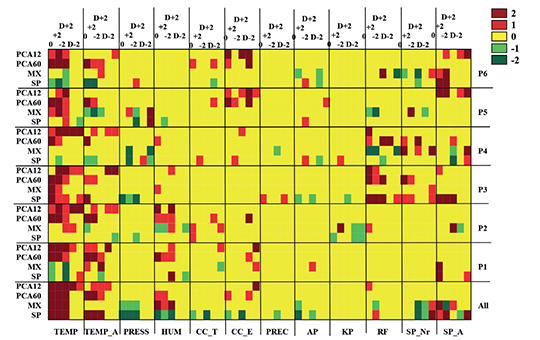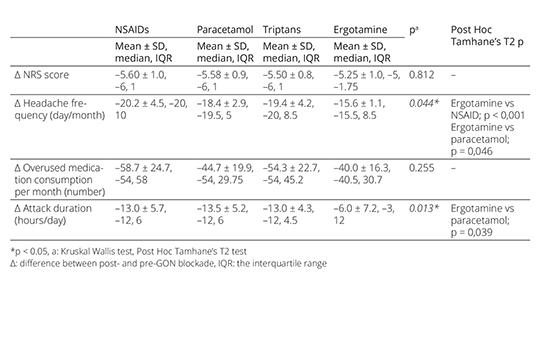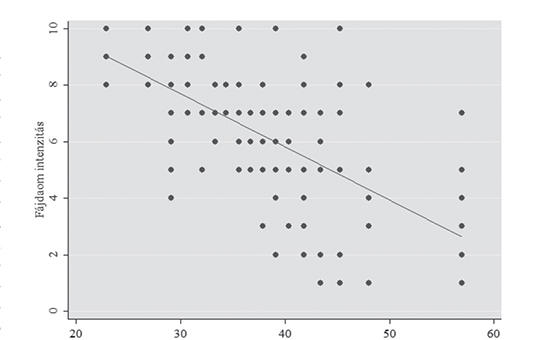The eLitMed.hu medical portal uses computer cookies for convenient operation. Detailed information can be found in the Cookie-policy.
Specialities
Pharmacy
Personalized analysis of pain–weather associations: a pilot study
It is a wellknown belief that weather can influence human health, including pain sensation. However, the current data are controversial, which might be due to the wide range of interindividual differences. The present study aimed to characterize the individual pain–weather associations during chronic pain by utilizing several data analytical methods.
The effect of anesthetic blockade of greater occipital nerve during the withdrawal period of the medication overuse headache treatment
Discontinuation of medication still remains a key element in the treatment of medication overuse headache (MOH), but there is no consensus on the withdrawal procedure. We aimed to share the promising results of anesthetic blockade of greater occipital nerve (GON), which can be an alternative to existing treatments during the early withdrawal period of MOH treatment.
This study was conducted using regular electronic medical records and headache diaries of patients diagnosed with MOH and treated with anesthetic GON blockade with 0.5% bupivacaine solution in a specialized headache outpatient clinic. A total of 86 patients who developed MOH while being followed up for chronic migraine were included in the study.
The treatment schemes for MOH are based on expert consensus and withdrawal strategies are the most challenging part of treatment. In our study, numerical rating scale for headache intensity, overused medication consumption per month, headache frequency (day/month) and the duration of each attack (hour/day) decreased significantly in the first month compared to pre-treatment (p < 0.01).
Conclusion – Our study suggests that GON blockade can be used as a good alternative therapy in the treatment of MOH.
Validity and reliability of the Turkish version of the Informant Assessment of Geriatric Delirium Scale
Delirium is a common complication developing in elderly patients. Therefore, it is important to diagnose delirium earlier. Family caregivers play an active role in early diagnosis of delirium and build a bridge between health professionals and patients. The purpose of this research was to achieve the validity and reliability of the Turkish version of the Informant Assessment of Geriatric Delirium Scale (I-AGeD).
This is a methodological study. The sample comprised 125 caregivers accepting to participate in the study and offering care to older patients with hip fracture aged ≥60 years. Data were gathered preoperatively and on postoperative days 0, 1 and 2. After achieving the linguistic and content validity of the scale, the known-groups comparison was used to achieve its construct validity. The ROC curve analysis was made to determine the sensitivity and specificity of the scale. Item-total correlations, item analysis based on the difference between the upper 27% and lower 27%, Kuder–Richardson 20 (KR-20) coefficient and parallel forms reliability with the NEECHAM Confusion Scale were adapted to assess discriminant indices of the items in the I-AGeD.
The item-total correlation coefficients of the scale ranged from 0.54 to 0.89 and KR-20 coefficient ranged from 0.09 to 0.91 depending on the measurement times. According to the ROC curve analysis, the sensitivity and specificity of the scale were ≥ 91% and ≥ 96% respectively. The parallel forms reliability analysis showed a highly significant, strong negative relation at each measurement between the I-AGeD and the NEECHAM Confusion Scale.
The I-AGeD is valid and reliable to diagnose delirium in older Turkish patients in perioperative processes.
Perineural 5% dextrose versus corticosteroid injection in non-surgical carpal tunnel syndrom treatment
We aimed to investigate the difference of clinical and electrophysiological improvement between perineural corticosteroid injection therapy (PCIT) and perineural 5% dextrose injection therapy (5%PDIT) in carpal tunnel syndrome (CTS).
Total of 92 wrists that were diagnosed as mild-to-moderate idiopathic CTS and completed their follow-up were included in our study. The severity of pain, symptom severity and functional status were assessed by visual analog scale (VAS) and the Boston Carpal Tunnel Syndrome Questionnaire (BCTQ) scores for treatment effectiveness. Randomized wrists were administered PCIT or 5%PDIT accompanied by ultrasound guidance. VAS, BCTQ scores and the electrophysiological study repeated before and after treatment at the 1st and 6th months after perineural injection therapies (PITs) were recorded.
Compared with baseline data, within groups there was significant improvement in VAS, BCTQ severity and function scores at 1st and 6th months follow-up (all p < 0.001). Considerable advance were detected in the median sensory nerve conduction velocity (SNCV) when pretreatment values were compared with posttreatment first month in both groups (p = 0.01; p < 0.001, respectively). No significant change occurred in median distal motor latency (DML) values between the 1st and 6th months in the groups (p = 0.095; p = 0.113, respectively). No significant difference was observed between 5%PDIT and PCIT groups.
Clinical and electrophysiologic improvement in CTS began from 1st month after PCIT and 5%PDIT. At the 6th month follow-up of the patients, 5%PDIT and PCIT had similar therapeutic effects. As a result, we can consider the replacement of PCIT with 5%PDIT in mild-to-moderate CTS patients especially in those who are hesitant because of the corticosteroid’s adverse effects.
[Comparison of pain intensity measurements among patients with low-back pain]
[Pain intensity is the most frequently assessed health domain in clinical studies among patients with low-back pain. Visual analogue scale (VAS) and Numeric rating scale (NRS) have been the mostly used measurement tools for pain intensity. We proposed to correlate these instruments to a generic health-related quality of life measurement tool in order to show the scale with superior clinical relevance.
We used cross-sectional, convenience sampling. 120 patients with chronic low-back pain administered the 29-item Patient Reported Outcomes Measurement Information System Profile with NRS included, and the VAS scale in the National Institute of Mental Health, Neurology and Neurosurgery. We determined the correlation between PROMIS domain T-scores and VAS and NRS scores.
We performed Spearman rank correlation test to calculate the correlation coefficient. We found VAS scales measuring pain had weak to moderate correlations with all PROMIS health domains (r = 0.24–0.55). Therefore, we compared correlation of PROMIS domain scores with PROMIS pain intensity numeric rating scale and VAS scales. PROMIS domains had moderate to strong correlations with pain intensity scale (r = 0.45–0.71). PROMIS physical function short form [r = –0.65, 95% CI (–0.75) – (–0.55)] and PROMIS pain interference short form (r = 0.71, 95% CI 0.63 – 0.79) had the strongest correlation with pain intensity item.
NRS has showed greater correlation with PROMIS domain T-scores than VAS scale. This may prove that NRS has greater connection to another health domains, thus it correlated more to health-related quality of life than visual scale. We recommend NRS to use in further clinical studies conducted among patients with low-back pain.]
[Middle meningeal artery embolization to treat acute epidural haematoma, case report and literature review ]
[The treatment of acute epidural haematoma is surgery as soon as possible, elimination of the source of bleeding and evacuation of the haematoma. In case of small epidural haematoma, strict neurological and radiological follow-up is necessary. In a significant percentage of cases, open surgery must also be performed within a few days. In case of small epidural haematomas, embolization of the middle meningeal artery is considered as an alternative solution. We review the literature on middle meningeal artery embolization and present our first treatment. Our case report is the first European report about an acute epidural haematoma which was treated by embolization of middle meningeal artery. Our case study is the first report in which a patient was treated with both open surgery and endovascular treatment for acute epidural haematoma within a year.]
1.
Clinical Neuroscience
[Headache registry in Szeged: Experiences regarding to migraine patients]2.
Clinical Neuroscience
[The new target population of stroke awareness campaign: Kindergarten students ]3.
Clinical Neuroscience
Is there any difference in mortality rates of atrial fibrillation detected before or after ischemic stroke?4.
Clinical Neuroscience
Factors influencing the level of stigma in Parkinson’s disease in western Turkey5.
Clinical Neuroscience
[The effects of demographic and clinical factors on the severity of poststroke aphasia]1.
2.
Clinical Oncology
[Pancreatic cancer: ESMO Clinical Practice Guideline for diagnosis, treatment and follow-up]3.
Clinical Oncology
[Pharmacovigilance landscape – Lessons from the past and opportunities for future]4.
5.









